
Artificial Intelligence (AI) is not a new concept in the world, but it has recently become one of the most hotly debated and critically examined topics. This is due to the remarkable advancements in AI technology, particularly the development of tools like ChatGPT, which have had a profound impact on various sectors, including education. While technology is advancing at an unprecedented pace, the progress of learning and education for many children worldwide is regressing, which is a cause for serious concern.
The Learning Poverty Report of 2022, a collaborative effort between UNESCO and the World Bank, has revealed deeply troubling statistics. In a group of low- to middle-income countries globally, it was discovered that approximately 70% of 10-year-old children are unable to read and comprehend simple passages. For Thailand, the figures are notably better at around 25%. Moreover, the report also highlighted that in Thailand, 1 in 7 individuals aged between 10 and 19 (14%) and 1 in 14 children aged 5 to 9 (7%) are grappling with severe mental health issues, which significantly impede their ability to learn.
On the one hand, AI offers hope that it can play a transformative role in addressing these disheartening statistics. The global education system is now confronted with the collective challenge of harnessing AI for teaching and learning in ways that maximize the potential of all learners, ensuring equity and efficiency.
Hence, the worldwide education system is collaboratively exploring methods to leverage AI in education to bring about positive changes.
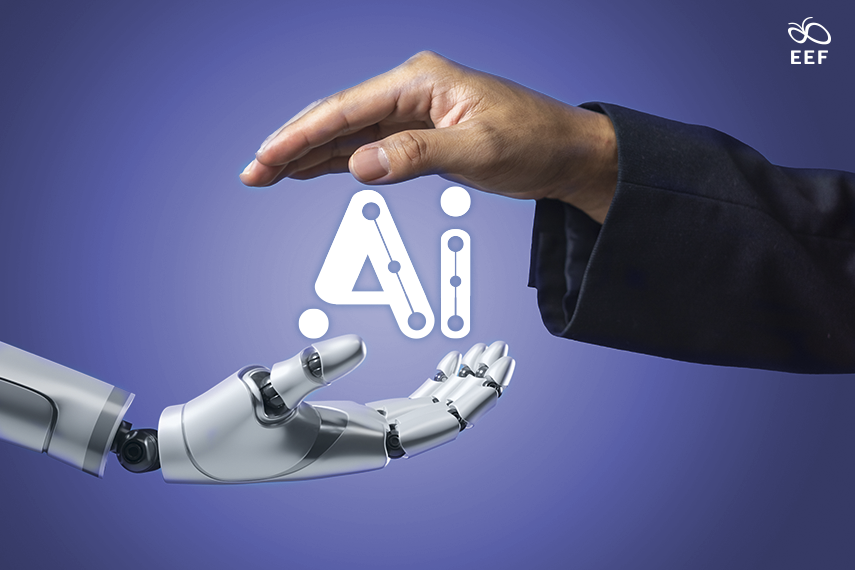
Trekees vs. Terminators: “Is AI a Tool for Creating ‘Nurturers’ or ‘Predators’?”
From the perspective of Dr. Ananta K. Duraiappah, AI and various digital tools can serve both as heroes and villains. The crucial determinant of whether AI acts as a tool for creating “Nurturers” or “Predators” for humanity lies in the moral and ethical values of those who wield these tools. Mainstream media has long presented representations of the roles of AI in both of these forms.
For example, in the Star Trek series (first aired in 1966), there is a character named Data, who is an android in human form. Data’s role is to receive commands from humans and carry them out to develop the world in ways that humans could never achieve. On the contrary, in the movie series The Terminator (first released in 1984), certain robotic characters are portrayed as evil entities that hunt down and destroy humans.
The portrayal of AI in these two forms has been presented in the media for a long time, highlighting the potential for AI to either nurture or prey upon humanity. Ultimately, the ethical principles and values of those who control these tools play a pivotal role in determining whether AI becomes a force for good or a potential threat to humanity.
The Universal Declaration of Human Rights by the United Nations, in Article 26, specifies the objective of education as “the full development of the human personality and the strengthening of respect for human rights and fundamental freedoms.” However, in many countries worldwide, the education system still adheres to a “One-Size-Fits-All” curriculum model and places significant emphasis on individuals who succeed based on their inherent abilities or follow a meritocracy approach. This approach tends to foster competition for educational success and encourages students to become hunters, competing against each other. Furthermore, it can be viewed as a violation of the basic human rights of students in the global education system, which includes over 1.8 billion individuals who should receive education that is equitable in terms of resources and tailored to their talents and needs. This approach also often overlooks children with disabilities or developmental challenges, preventing them from accessing suitable education and denying them the opportunity to reach their full potential.
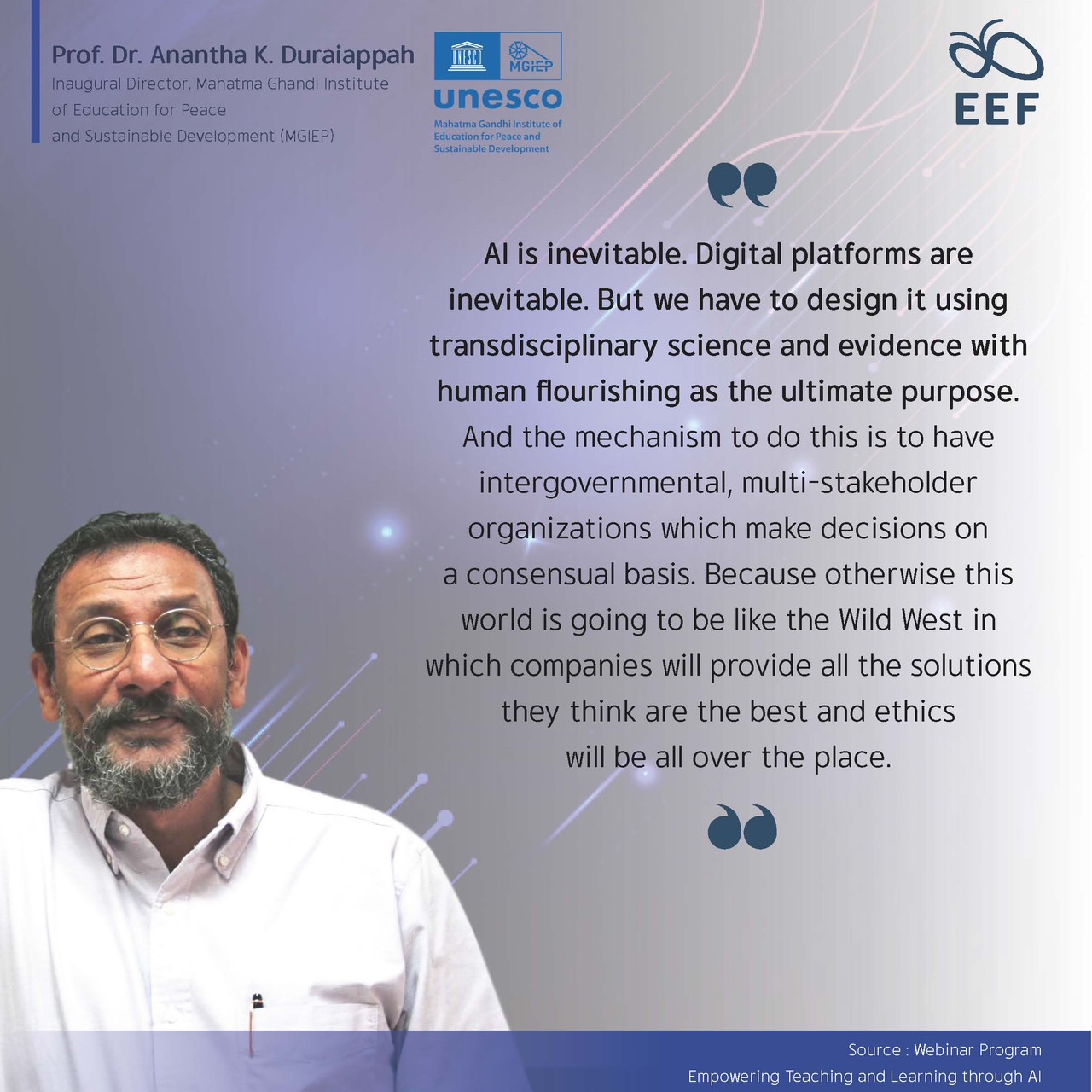
In the present world, we can no longer deny the essential role of AI in the teaching and learning processes. Rather than debating the appropriateness of integrating AI into education, the global community should come together to find ways to design educational systems that effectively incorporate AI. When designing such educational systems, it is imperative to steadfastly uphold the primary goal of education: to maximize the potential of learners and guide them towards the fulfillment of human potential, and, most importantly, to remain unwavering in our commitment to ethical principles.
Harnessing AI in Education
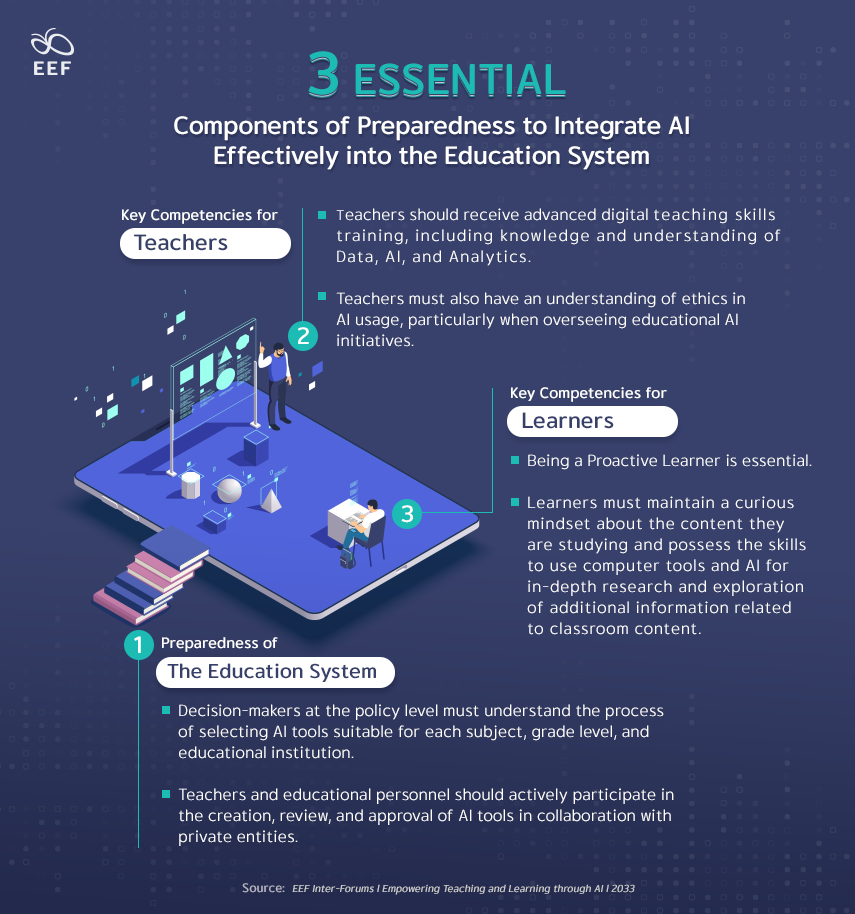
To integrate AI effectively into the education system, there needs to be preparedness across three essential components: 1) Preparedness of the education system; 2) Key competencies for teachers; and 3) Key competencies for learners.
- Preparedness of the education system:
-
- Decision-makers at the policy level must understand the process of selecting AI tools suitable for each subject, grade level, and educational institution. They should be aware of how these tools address learning outcomes and which metrics they use for assessing such outcomes.
- It is advisable to establish an international governmental body focused on AI in education, particularly to review and grant approval for AI tools before their actual implementation in teaching. This would be similar to the review and approval process for general textbooks. Currently, only a few private companies dominate the production and control of tools and data. Teachers and educational personnel should actively participate in the creation, review, and approval of AI tools in collaboration with private entities.
- Key competencies for teachers:
-
- Teachers should receive advanced digital teaching skills training, including knowledge and understanding of Data, AI, and Analytics. This training will enable them to understand how to integrate AI into the curriculum in alignment with learning objectives.
- Teachers must also have an understanding of ethics in AI usage, particularly when overseeing educational AI initiatives. Establishing ethical guidelines for AI usage, specifically designed for teachers, should be considered by relevant AI oversight bodies. Additionally, teachers should receive training in SEL skills to cultivate a steadfast ethical mindset in their teaching practices.
- Key competencies for learners:
-
- Being a Proactive Learner is essential. Learners must maintain a curious mindset about the content they are studying and possess the skills to use computer tools and AI for in-depth research and exploration of additional information related to classroom content. Similarly, just like teachers, students need to receive ethical guidelines for AI usage and be trained in SEL skills to a level where they can ethically and responsibly utilize AI tools.

As an example of how AI is being used in the education system, MGIEP has developed a platform called “FramerSpace,” which serves as a Learning Experience and Analytics Platform. Teachers can utilize this platform to assist in creating their courses through user-friendly tools that do not require advanced coding skills. Additionally, the platform offers a wide range of public courses that are open for teachers worldwide to access and learn independently. These courses include topics such as Digital Teacher training, Introduction to AI, Social and Emotional Skills training, as well as various educational games, among others.
Discussion on “Transforming Education with AI: Smart and Creative Learning” by Dr. Pathapong Pongpatrakant, Department of Educational Technology and Communication, Faculty of Education, Naresuan University, Phitsanulok
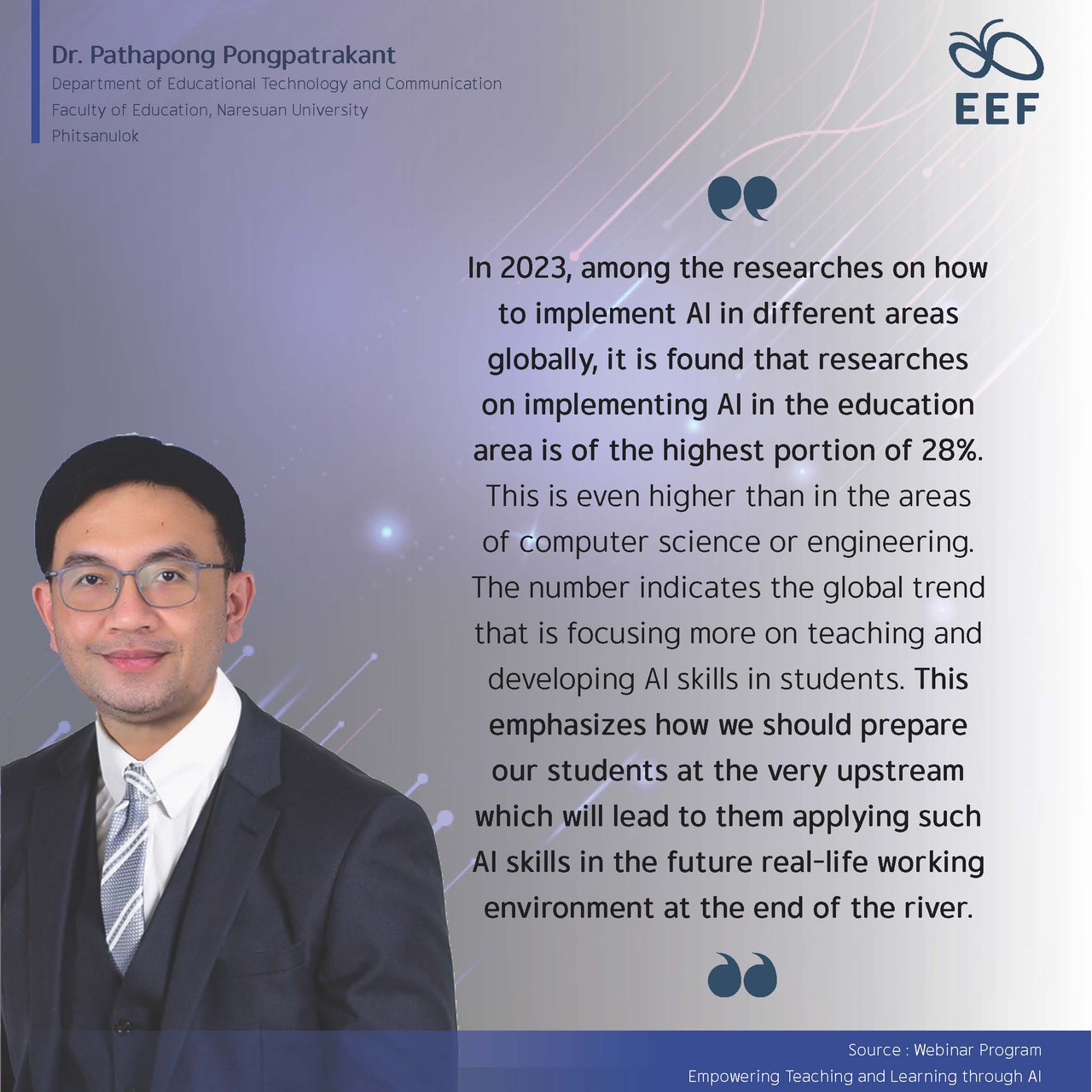
In 2023, research studies around the world have shown a significant focus on the application of AI in various fields, with education emerging as the highest area of interest, accounting for 28% of research, surpassing computer science (20%) and engineering (11%). This global trend underscores the increasing importance placed on imparting knowledge and fostering AI skills among students.
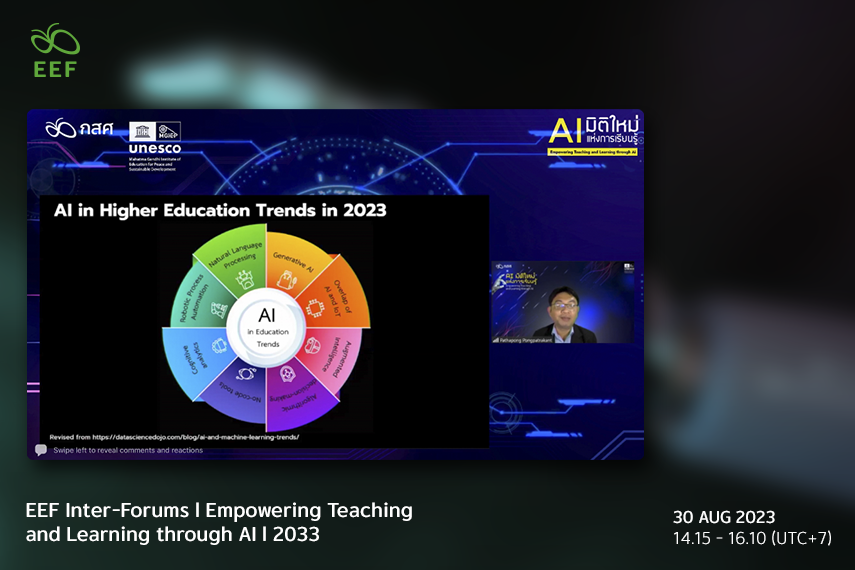
In Thailand, there is a growing adoption of AI applications, both from international sources and domestic innovation. These applications are widely used in teaching and learning, curriculum design, and teacher training. Currently, the Faculty of Education at Naresuan University is designing an AI-Based Learning management system, that is intended to be implemented in schools within the university’s network in the future.
Notable Thai AI tools include “e-CLIP” (Electronic Content-Language Integrated Pedagogy), an innovation that integrates electronic content with language to enhance teaching and learning. The “Alisa” AI Chatbot, compatible with the Thai language and accessible through the LINE application, is another interesting tool. Additionally, the “AI FOR THAI” platform offers AI technology services tailored for the Thai population and is developed by the National Electronics and Computer Technology Center (NECTEC).
Discussion on “Preparing Thai Children to be the Master of AI” by Assoc. Prof. Dr. Thanyawich Vicheanpant, Director of the Office of Research and Innovation Development, Sripatum University, Chonburi Campus
Integrating AI tools into the education system in Thailand, particularly at the primary and secondary levels, requires a practical and hands-on approach. This is because children at this age may not fully grasp the benefits of AI, and teachers should focus on enhancing various skills and encouraging students to use their abilities through various activities. In this context, AI should serve as an assisting tool.
One example of AI integration into localized problem-solving activities comes from a primary school in Chonburi province. Students surveyed local water sources and discovered that there was an unauthorized discharge of wastewater from the community into natural water sources. To address this issue, students collectively devised a small underwater vessel using PVC pipes and bottle caps, equipped with light intensity sensors to detect pollution levels underwater. They utilized AI tools to simulate the operation of the underwater vessel controlled via radio signals and employed basic coding programs.
This activity allowed students to apply their creative thinking, analytical skills, and problem-solving abilities while incorporating technology to achieve their goals.
Summary during the Q&A session

Promoting Access to AI for Students in Smaller Schools
Prof. Dr. Anantha: Currently, the size of the school is not significant for accessing AI in the future. What matters is the ability to access the internet and the necessary tools. The terms “school” or “classroom” must undergo a complete paradigm shift because these places no longer have physical significance. We are facing challenges in managing mixed reality learning, where we continuously switch between physical and virtual realities.

Appropriateness of Using AI in Primary-level Education
Assoc. Prof. Dr. Thanyawich: Teachers can use AI as a supplementary tool for teaching primary school children in certain subjects. Teachers need to ensure that children understand that AI is not the primary tool for learning to avoid excessive reliance on AI. Additionally, teachers should link AI to real-life situations and problem-solving scenarios.
Prof. Dr. Anantha: It is necessary to develop social and emotional skills to instill ethical values in children, particularly empathy, and to make them aware of the ethical consequences of using AI. This concept sounds simple but is challenging to implement. Currently, MGIEP is developing an ethics handbook specifically for using AI in education.

State Budget Support for AI
Prof. Dr. Anantha: MGIEP has developed a Digital Readiness Index, which considers all components in the education budget chain in different countries to determine how much budget allocation is needed at each point to achieve results in training children’s digital skills. The report found that the most critical area requiring the highest budget allocation is building teachers’ competencies and content development. However, there is very little budget allocated to these aspects currently.
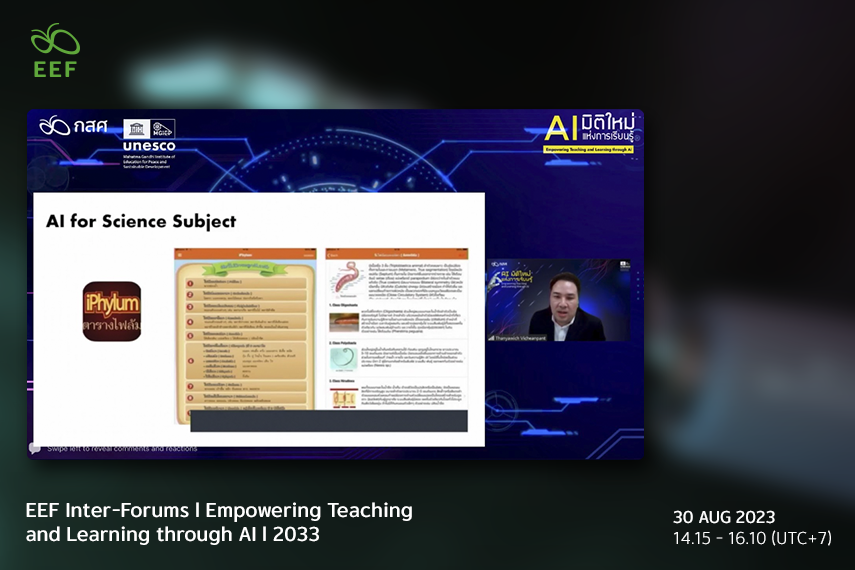
Assoc. Prof. Dr. Thanyawich: Currently, educational institutions in Thailand can create digital education plans and specify the benefits of using AI in education. Afterward, they can request support from various agencies, such as the Educational Technology Development Fund (EDTECH FUND) or the Equitable Education Fund (EEF), for support.
Source: EEF Inter-Forums l Empowering Teaching and Learning through AI l 2033
Watch EEF Inter-Forums: https://web.facebook.com/watch/?v=1316689959224256

